- Prelude
- Editorial
- 'Public Sculptures are the Public's own Consciousness'
- Stimulating Thoughts
- Sculptural Traditions and Contemporary Art Practices
- Sculpting out a Third Dimension from Madhya Pradesh
- About Nostalgic Dragonflies and Homes in the Bags: Sculptural Snapshots from the North-East
- A Concise Chronicle of Bengal's Modern Sculpture
- Neo-sculptural Identity: Six Young Sculptors
- From Object to Experience: Notes on American Sculpture
- In the Domain of Drama Sculptures of S.Nandagopal
- Satish Gujral : Sculpting the Inner Form
- Transformation of Articulations: Mrinalini Mukherjee
- The Experiential Quotient in the Sculptures of Ravinder Reddy
- Shresta Rit Premnath A Passion for Structure
- The Anatomy of Melancholy: Sculptures of Rajesh P Subramanium
- A Crusader of/for Site Specific Public Art: Subodh Kerkar
- Installation Practices in and around Santiniketan
- A Wall is a Screen: A Promenade Film Street Performance
- Jaeger-LeCoultre An Overview
- Regency Style: Regency Furniture
- Designing the Streetscapes: Visual Elements of Pedestrian Corridors
- Sculpture Rules It All
- The Triumph of the Eternal
- Artist Index and Statistics- Anish Kapoor
- Auction Reports
- Musings from Chennai
- Art Bengaluru
- Art Events Kolkata: October-November 2010
- Mumbai Art Sighting
- An Evening of Interaction
- 6th Asian Museum Curators' Conference
- Swedish Art in India
- Couple of Difference : Recent sculptures of Karl Antao
- Previews
- In the News
- Sotheby's : Important Watches Geneva
ART news & views
Installation Practices in and around Santiniketan
Volume: 3 Issue No: 11 Month: 12 Year: 2010
by Vishal Tondon
Since its very inception, Santiniketan has had a practice of ritual-based community events. Initially, these helped foster the spirit of nationalism, inculcate a spirit of community, and create a role model for civic life in the soon-to-be an independent and free young India.  Tagore made a conscious effort to appropriate the models of religious rituals and apply them to the non-religious, secular community activities such as Briksharopan (a ceremonial planting of trees) and Vasanto-Utsav (celebration of spring, more popularly known as holi). Integral to these rituals and programs was décor; the decorative paraphernalia and hand-made objects. Things were arranged, installed and new connotations created. Kala Bhavana participated in these events with its own unique inputs mainly from Nandalal Bose, and also invented certain details of these rituals. Being characteristically secular, these rituals were open to creative interventions and had a close association with nature; invocation of nature was one central objective of these rituals. For instance, special attention was paid to using locally available and natural material like foliage, flowers and the vocabulary of indigenous art and craft. Even the clothes used as decorative edgings or for canopy and costumes were spun, dyed, embroidered and painted locally all of these can be regarded as a precursor of what we today know as installations and outdoor sculptures.
Tagore made a conscious effort to appropriate the models of religious rituals and apply them to the non-religious, secular community activities such as Briksharopan (a ceremonial planting of trees) and Vasanto-Utsav (celebration of spring, more popularly known as holi). Integral to these rituals and programs was décor; the decorative paraphernalia and hand-made objects. Things were arranged, installed and new connotations created. Kala Bhavana participated in these events with its own unique inputs mainly from Nandalal Bose, and also invented certain details of these rituals. Being characteristically secular, these rituals were open to creative interventions and had a close association with nature; invocation of nature was one central objective of these rituals. For instance, special attention was paid to using locally available and natural material like foliage, flowers and the vocabulary of indigenous art and craft. Even the clothes used as decorative edgings or for canopy and costumes were spun, dyed, embroidered and painted locally all of these can be regarded as a precursor of what we today know as installations and outdoor sculptures.
Of particular interest is the practice of outdoor art as a kind of public art especially that by Ramkinkar Baij absolutely different from the prevalent practice of Nationalist statues of Baij's time. These were made open air, without much fuss about longevity or sanctity accorded to the material used. 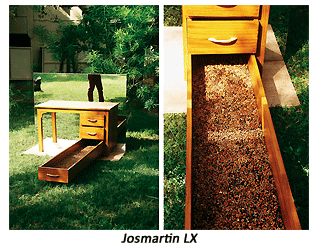 They were intended to be a part of the environment, and for the enjoyment of the local inhabitants. They were inspired either by the ways of the indigenous people or by literary characters.
They were intended to be a part of the environment, and for the enjoyment of the local inhabitants. They were inspired either by the ways of the indigenous people or by literary characters.
We now have a specific definition of what installation practice is. It is interesting to note that Briksharopan even now fits the bill as far as a contemporary definition of a performance-installation is concerned. A tree is ceremoniously planted every year on this day, and the ritual is a symbol of the larger efforts to create greenery in and around Santiniketan. To analyze the activity according to modern criteria, Briksharopan is a site specific and recurring event. It follows real-time practices, and is of a performative nature as the process involves the intention and active participation of the public.
In the West, site-specific and performance-oriented installation practices began with the motive of challenging the constraints and the hold of the white cube that is the gallery space, and moving the art object and the creative activity out of this space. Traditionally an art object, a painting to be more specific engaged with the viewer in a visual dialogue. Now, an installation transforms visual dialogue into a multisensory experience,  where the viewer who is either participating in or intruding into the space of the installation is engaged with the installation through sound, sight, and physical relationship with the objects. In Kala Bhavana, this discourse happened by way of casual workshops and Nandan Mela activities, rather than as a part of the curriculum. This owed to the tradition of considering art as a community activity rather than as an elitist one reaching out to a discerning few. Also, the annual activity of Jago-Jhompo a musical play enacted every year during the Kala Bhavana annual art fair 'Nandan Mela' used the technical aspects of projection images, light and shadow, and live performance as improvisations of theatrical activity. Though not done with the intention of performances and installations as done in the West, Jago-Jhompo did experiment with visual tools, spaces and multimedia.
where the viewer who is either participating in or intruding into the space of the installation is engaged with the installation through sound, sight, and physical relationship with the objects. In Kala Bhavana, this discourse happened by way of casual workshops and Nandan Mela activities, rather than as a part of the curriculum. This owed to the tradition of considering art as a community activity rather than as an elitist one reaching out to a discerning few. Also, the annual activity of Jago-Jhompo a musical play enacted every year during the Kala Bhavana annual art fair 'Nandan Mela' used the technical aspects of projection images, light and shadow, and live performance as improvisations of theatrical activity. Though not done with the intention of performances and installations as done in the West, Jago-Jhompo did experiment with visual tools, spaces and multimedia.
On the occasion of Nandan Mela, outdoor or environmental works are done with great zeal and creativity. Here often the idea is to enliven the campus space with something stunning in terms of the visual idea, scale, and most importantly, the material. One such example is the light installations by Kaumudi Patil. Simple material like dry leaves, 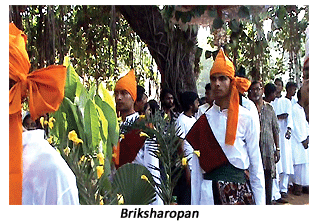 or bamboo structures convert the space into something unusual, different, and unfamiliar. They transform a known space into a new experience, as in the installation by Ashish Ghosh and his friends. The outdoor sculptures affect the visual atmosphere greatly. Last year, the giant interactive puppet created by the students engaged the visitors, young and old alike, in a playful and fun activity.
or bamboo structures convert the space into something unusual, different, and unfamiliar. They transform a known space into a new experience, as in the installation by Ashish Ghosh and his friends. The outdoor sculptures affect the visual atmosphere greatly. Last year, the giant interactive puppet created by the students engaged the visitors, young and old alike, in a playful and fun activity.
The newer practices of performance and installation in the West by influential artists were not to directly influence their inclusion in the curriculum at Kala Bhavana. In fact, Kala Bhavana yet does not officially have installation and performance arts in the curriculum. The transfiguration of community based activities which were so inherent in the fabric and the lifestyle of Santiniketan into newer versions like “installation art” and “performance art” came through the interventions in the early 1990s by foreign students accepted into the MFA programs.
In the year 2000, Sanchayan Ghosh created 'A Few Hanged Stars and a Crossed Memoir', a site specific installation performance. 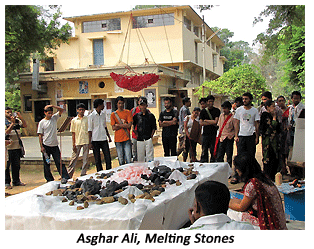 The performance-installation was created in the space between the two Ramkinkar Baij sculptures, 'The Santhal Family' and 'The Mill Goers'. The performers read out, as a homage, letters written by now famous artists who were unacknowledged in their own times. Thus, Ramkinkar Baij was witness to the readings of the letters of the poets Jibanananda Das and Sukanto, the film maker Ritwik Ghatak, and the artist Van Gogh amongst others; a new space was created out of every day, regular space. The transformation of space provoked and transformed our activities around it.
The performance-installation was created in the space between the two Ramkinkar Baij sculptures, 'The Santhal Family' and 'The Mill Goers'. The performers read out, as a homage, letters written by now famous artists who were unacknowledged in their own times. Thus, Ramkinkar Baij was witness to the readings of the letters of the poets Jibanananda Das and Sukanto, the film maker Ritwik Ghatak, and the artist Van Gogh amongst others; a new space was created out of every day, regular space. The transformation of space provoked and transformed our activities around it.
To re-assess the outcomes of a living tradition like Briksharopan, on 1st August 2004 Sanchayan Ghosh and a group of students went out on a bicycle expedition around Santiniketan to locate the trees planted annually since the times of Tagore. A census of the trees was conducted, and placards mentioning 'the year of birth' were installed by the trees that could be located. As for the trees that had disappeared, the placards mentioned 'missing'. 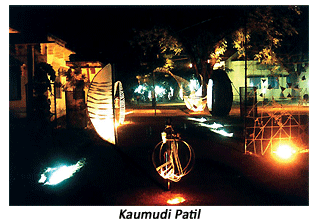 The study revealed a newer geometry of a now much fragmented Visva-Bharati. The authorities were notified; where had so many trees gone missing? This was a kind of an excavation project into the history of Visva-Bharati which was originally meant to be an open campus interspersed with indigenous units of locals. But now the space had evolved itself into disjointed parts.
The study revealed a newer geometry of a now much fragmented Visva-Bharati. The authorities were notified; where had so many trees gone missing? This was a kind of an excavation project into the history of Visva-Bharati which was originally meant to be an open campus interspersed with indigenous units of locals. But now the space had evolved itself into disjointed parts.
Kaumudi Patil's installation for Vasanto-Utsav showed her concern for the nature; she tied sacred threads around the tree, the flowers of which are used to make the natural dye used in Vasanto-Utsav, and gave us the message that we should revere and use natural resources judiciously.
Similarly, Ashish Ghosh's installation “Creepers Revealed” at Sriniketan, is an example of art that doesn't interfere with space, but becomes a part of it. Further, it fondly remembers the creepers that are now becoming rare in the surrounding landscape due to rampant human interference.
Activities that elicit the participation of viewers, as in the case of “Evolving Sculpture” by Sajad Hamdani during the year 2002, 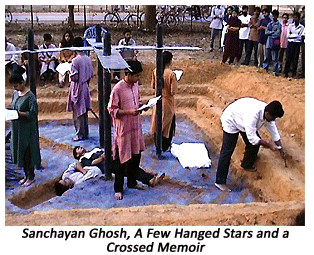 are a clear example of how art transcends the private domain and becomes public. Rejects from the Sculpture and the Ceramics Departments were shared with the students and viewers, and they were encouraged to develop a structure out of it as per the dictates of their own choice.
are a clear example of how art transcends the private domain and becomes public. Rejects from the Sculpture and the Ceramics Departments were shared with the students and viewers, and they were encouraged to develop a structure out of it as per the dictates of their own choice.
More recent activities include installations like “Melting Stones” by Asghar Ali, which reveals social concerns. Some installations are about more personal concerns and subjective feelings, like Josmartin LX's work made during the students' submission this year.
Thus we see that though not all installation art practices are saleable due to their temporality and site-specificity, they are important interventions and intellectual discourses on society and our relation with our surroundings. Also, if one is more aware of the aesthetics and implications of such works of art, we can encourage the proliferation of this kind of cultural practice in public and corporate spaces.